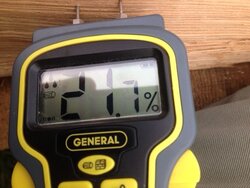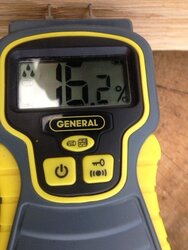At least with oak splits that is.
The first picture is of a split that I recently hit with the moisture meter. It is white oak that I scored about a year ago (avatar pic) and split right away and stacked in a pretty good location with good sun and wind but no cover at all. It is a fresh split but from a larger piece. You can see that it read too high to burn this year.

The next picture comes from the same species and same stack, but a piece about half the size. You can see that it is ready to burn this winter if I need to. I have recently been hand splitting about 1.5 cords of red oak and have made every effort to make the splits small since I have limited space and need a pretty quick turn around in when I burn them. I hope to burn the new oak during the colder periods of 2013-14. I have also taken most of the bark off of the red oak as I think it helps it season faster. Is it worth doing that?

I appreciate all the sage advice from you all!
The first picture is of a split that I recently hit with the moisture meter. It is white oak that I scored about a year ago (avatar pic) and split right away and stacked in a pretty good location with good sun and wind but no cover at all. It is a fresh split but from a larger piece. You can see that it read too high to burn this year.

The next picture comes from the same species and same stack, but a piece about half the size. You can see that it is ready to burn this winter if I need to. I have recently been hand splitting about 1.5 cords of red oak and have made every effort to make the splits small since I have limited space and need a pretty quick turn around in when I burn them. I hope to burn the new oak during the colder periods of 2013-14. I have also taken most of the bark off of the red oak as I think it helps it season faster. Is it worth doing that?

I appreciate all the sage advice from you all!




